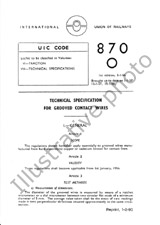We need your consent to use the individual data so that you can see information about your interests, among other things. Click "OK" to give your consent.

UIC B126/RP52-1ed.
Braking Issues - Braking performance deficit on trains consisting of wagons for combined transport - Root cause analysis and countermeasures
Translate name
STANDARD published on 1.5.2019
The information about the standard:
Designation standards: UIC B126/RP52-1ed.
Publication date standards: 1.5.2019
SKU: NS-1190239
The number of pages: 67
Approximate weight : 201 g (0.44 lbs)
Country: International technical standard
Category: Technical standards UIC
Annotation of standard text UIC B126/RP52-1ed. :
During a major brake testing campaign conducted between 2011 and 2013, SBB found that there was a significant lack of braking performance on so-called UCT trains (Unaccompanied Combined Transport, i.e. container transporters and pocket wagons) on the transalpine axis D/F - CH - I. The present UIC project was implemented in order to ascertain the reasons for this finding. The investigations carried out by the UIC working group B 126.24 show that the lowering of the braking performance is imputable neither to a malfunction of the load-weighing device nor to a long propagation time of the braking command in the brake pipe. Concerning the brake rigging efficiency, many measurement data have been collected. A high var-iability in results was observed during the assessment of dynamic efficiency. As UCT wagons are equipped with various types of brake rigging designs, and as designers have used different theo-retical values for the average dynamic efficiency between two revisions, an explicit assessment on how far braking performance is compromised by low rigging efficiency could not be realised yet by the working group. The working group therefore recommends to UIC to carry out, as part of a new project, a comple-mentary analysis focused on the impact of brake rigging efficiency on the real braked weights ob-tained in service, in comparison with the braked weights marked on the vehicles.
Name:Fragen des Bremswesens - Mangelnde Bremsleistung in Zügen mit Wagen des Kombinierten Verkehrs - Analyse der Ursachen und Gegenmaßnahmen|Die SBB stellte in ihrer breit angelegten Bremsversuchskampagne von 2011-2013 einen signifikanten Mangel an Bremsleistung in UKV-Zügen (d.h. Zügen des unbegleiteten Kombinierten Verkehrs) auf der Alpenquerung D/F - CH - I fest. Im Rahmen des nachstehend beschriebenen UIC-Projekts sollten die Ursachen für dieses Phänomen eruiert werden. Die Untersuchungen der UIC-Arbeitsgruppe B126.24 ergaben, dass die verminderte Bremsleistung weder auf die Wiegeeinrichtungen, noch auf eine lange Durchschlagszeit des Bremsbefehls durch die Bremsleitung zurückzuführen ist. Es wurde eine Vielzahl von Daten zum Bremsgestängewirkungsgrad zusammengetragen. Bei der Bewertung des dynamischen Wirkungsgrades wurde festgestellt, dass sich die Ergebnisse stark unterscheiden. Da die Wagen des unbegleiteten kombinierten Verkehrs mit unterschiedlichen Bremsgestängetypen ausgerüstet sind und die Hersteller verschiedene theoretische Werte für den durchschnittlichen dynamischen Wirkungsgrad zwischen zwei Revisionen ansetzen, war die AG bisher noch nicht in der Lage zu beurteilen, inwieweit die Bremsleistung tatsächlich durch einen niedrigen Gestängewirkungsgrad beeinträchtigt wird. Die AG empfiehlt der UIC daher, im Rahmen eines neuen Projekts eine ergänzende Analyse mit Fokus auf den Auswirkungen des Bremsgestängewirkungsgrades auf das tatsächlich im Betrieb vorhandene Bremsgewicht im Vergleich zu dem am Wagen angeschriebenen Bremsgewicht zu erstellen.
We recommend:
Technical standards updating
Do you want to make sure you use only the valid technical standards?
We can offer you a solution which will provide you a monthly overview concerning the updating of standards which you use.
Would you like to know more? Look at this page.



 Cookies
Cookies
